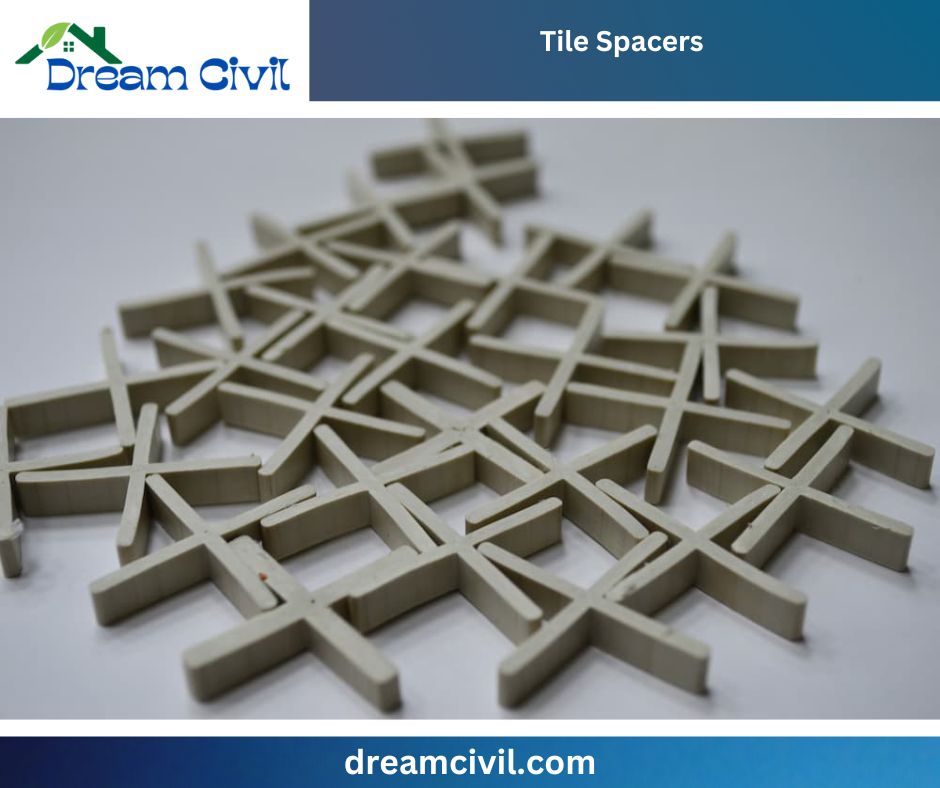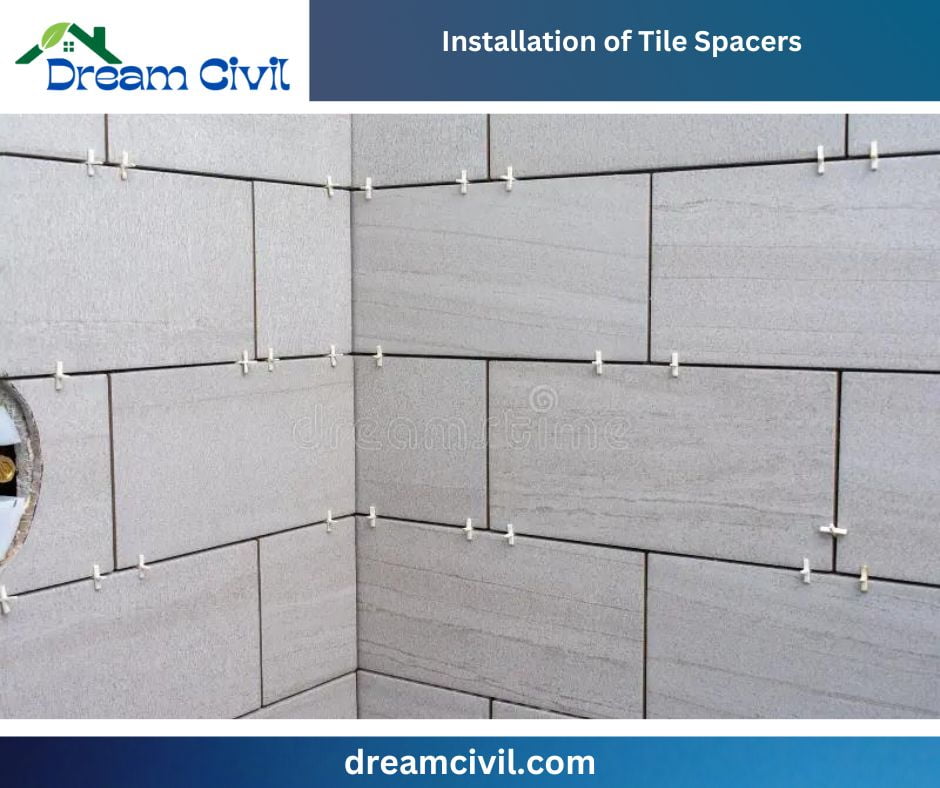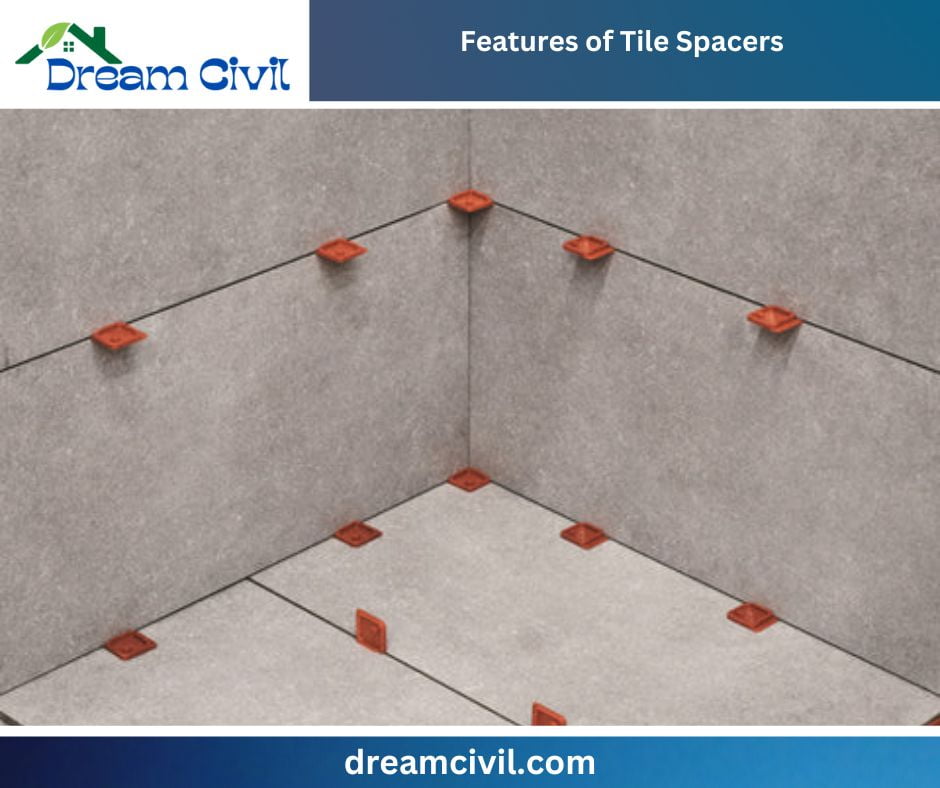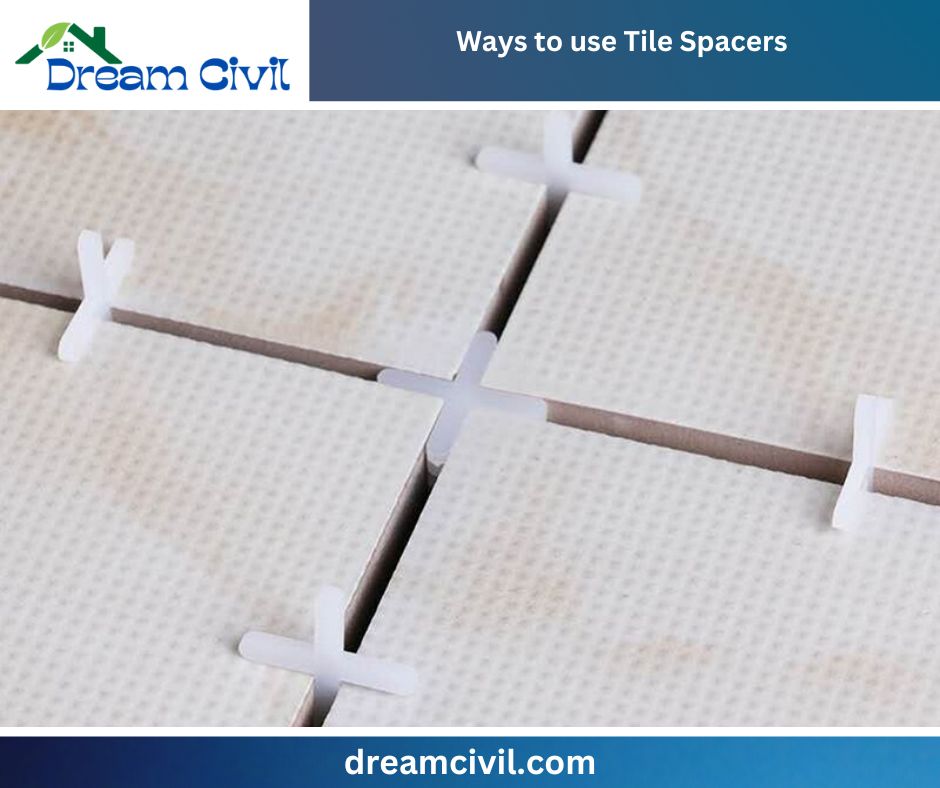Table of Contents
✔ Tile spacers are small plastic or rubber devices utilized in tile installation to retain uniform gaps between tiles.
1. What are the types of material being used in tile spacers?

| Type of Tile Spacer | Description |
| Plastic Tile Spacers | ✔ Widely used and highly available ✔ Available in diverse sizes and shapes ✔ Lightweight, affordable, and easy to operate ✔ Favorable for most tile installations like ceramic, porcelain, and glass tiles. |
| Rubber Tile Spacers | ✔ Flexible and can compress slightly ✔ Ideal for irregular and natural stone tiles ✔ Allow for variations in tile thickness. ✔ It is reusable and provides a tighter grip on tiles. |
| Foam Tile Spacers | ✔ Soft and compressible ✔ Suitable for delicate and fragile tiles like glass or marble ✔ Available in various thicknesses ✔ Easy to remove after tile adhesive sets ✔ Gentle on tile surfaces. |
| Cork Tile Spacers | ✔ Eco-friendly and absorbs excess moisture from tile adhesive ✔ Prevent tile staining or warping ✔ Commonly used for ceramic and porcelain tiles ✔ Biodegradable and provide good support during tile installation. |
| Metal Tile Spacers | ✔ Durable and resistant to deformation ✔ Suitable for heavy-duty tile installations and large-format tiles ✔ It is reusable and offers stability in demanding conditions. |
| Cross-Polymer Tile Spacers | ✔ Combine the flexibility of rubber with the durability of plastic ✔ Designed for precise alignment ✔ Adapt to variations in tile thickness ✔ Suitable for a wide range of tile types. |
| Composite Tile Spacers | ✔ Blend different materials to achieve specific properties ✔ Example: combining plastic and rubber for flexibility and grip ✔ Offer a balance of advantages from multiple materials. |
| Wooden Tile Spacers | ✔ It is less common but used for specific tile installations ✔ Biodegradable and can absorb excess moisture from adhesives ✔ Typically used for rustic or decorative tile projects. |
| Hybrid Tile Spacers | ✔ Combine two or more materials for unique benefits ✔ They are tailored to specific applications for durability, flexibility, or ease of use. |
2. How do you choose the correct tile spacers for your project?

When choosing tile spacers, consider the following aspects:
| Consideration | Tile Spacer Selection |
|---|---|
| Size and Type of Tile | ✔ Choose spacers based on the size and type of your tiles. ✔ For small ceramic tiles, select smaller spacers; for large porcelain tiles, opt for larger spacers. |
| Grout Joint Width | ✔ Determine the essential width of the grout joint. ✔ Grout joint widths can vary from 1/16 inch to 1/2 inch, depending on your project style and tile type. ✔ Adjust spacer size accordingly. |
| Levelness of the Subfloor | ✔ Assess the subfloor’s level. ✔ If the subfloor is uneven, you may require larger spacers to ensure the tiles generate a level surface during installation. |
Some common guidelines for preferring tile spacers:
| Tile Type | Recommended Tile Spacer Size |
|---|---|
| Small Ceramic Wall Tiles | ✔ 1/8 inch or 3/16 inch |
| Large Ceramic Floor Tiles | ✔ 1/4 inch or 3/8 inch |
| Porcelain Tiles | ✔ 3/16 inch or 1/4 inch |
| Natural Stone Tiles | ✔ 1/4 inch or 3/8 inch |
| Mosaic Tile Installations | ✔ 1/4 inch or 3/8 inch |
3. How to install tile spacers?

✔ Firstly, Apply the tile spacers on the subfloor.
✔ Set a tile spacer at each corner of each Tile.
✔ Employ a level to make sure about the leveled tile spacers.
✔ After placing tile spacers, then start installing the Tile.
✔ Make sure to let the adhesive dry entirely after installing the Tile.
✔ After the adhesive has dried, remove the tile spacers.
4. What are Important Features of Tile Spacers?

✔ They are in the market in width sizes ranging from 2 mm to 6 mm.
✔ Lightweight and sturdy plastic is the prior material for spacer manufacture.
✔ The selection of spacers relies on personal choice and the rules.
✔ Proper tile spacing with tile spacers permits free movement of the Tile to consider the stress ease.
✔ The spacers utilized for walls take the lowest value of 2 mm, and the floor spacers create a size of 3 mm.
5. For What purpose are the tile spacers being used?

| Alignment: | ✔ Ensures straight and even tile placement. |
| Uniformity: | ✔ Prevents misalignment and pattern issues. |
| Aesthetic Appeal: | ✔ Enhances overall visual appearance. |
| Structural Integrity: | ✔ Reduces the risk of cracks or shifts. |
| Grout Application: | ✔ Facilitates stable and neat grouting. |
6. What are the ways to use Tile Spacer?

✔ Foremost, set the tiles on the ready surface with a coating of adhesive. Now, keep the spacers at each corner of the Tile.
✔ Place the spacers instantly on the tile corners and push the Tile jointly until the Spacer is thoroughly maintained to each edge of the Tile. This process allows for making sure of an equal space between each Tile.
✔ The pieces of tile spacers utilized equal the number of tiles multiplied by four. It is suggested to purchase more to account for any damage or loss of spacers during the laying process.
✔ Another essential issue to remember while utilizing spacers is their discarding. Pull the tile spacers before inserting them with the underlying mortar or the adhesive.
✔ Tile spacers should be released 20 to 30 minutes after the adhesive sets with the Tile.
7. What are the Advantages and disadvantages of Tile Spacers?
Advantages:
✔ Maintains straight and even grout spacings.
✔ Aids in estimating, labeling, and cutting tiles.
✔ Results in a professional and attractive finish.
✔ Preserve the integrity of tile floors.
✔ Reusable if handled carefully.
✔ Ensures even spacing for a polished appearance.
✔ Maintains consistent grout joints for durability.
✔ Helps prevent lippage for flush tile installation.
✔ Simplifies the installation process, especially for beginners.
Disadvantages:
✔ Increases the construction cost.
✔ Time-consuming need to fix and remove later after 20-30 minutes.
✔ A skilled workforce is needed.
✔ High chance of damage, and can lose quickly.
8. What common mistakes must be avoided when using tile spacers?
✔ Insufficient tile spacers.
✔ Inappropriate size of tile spacers.
✔ Wrong installation of the tile spacers.
✔ Dragging the tile spacers too soon.
✔ Operating the inaccurate type of tile spacers.
9. What is the range of prices for Tile Spacers?
✔ The rule is to utilize spacers of 2 – 3 mm for a ceramic wall tile structure and tile spacers of 5 mm for a ceramic floor tile fixing, but various elements can affect the size of the spacers utilized.
✔ Porcelain, granite, and marble tiles are typically set with a 3 mm spacer.
✔ Tile spacers are available in the following sizes: 1.5875, 3, 4.7625, 6.35, and 9.525 mm.
✔ Tile spacers can be used again and again if handled with care.
✔ The commonly used Spacer is 3mm with the price of $2.97 for 100 pcs.
| Read Also: Aircrete |
| Verified By: Er. Bipana Kshetri Puri |

